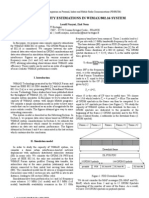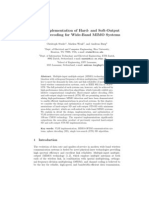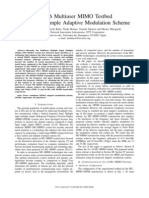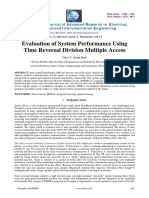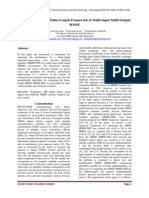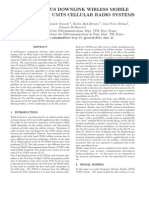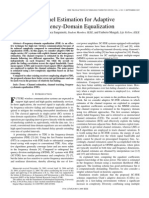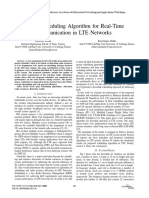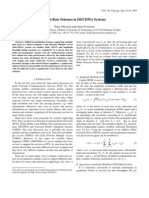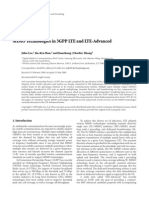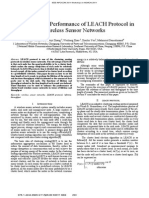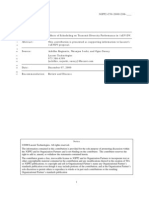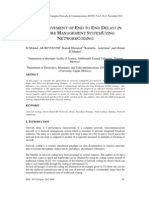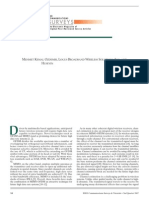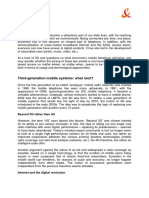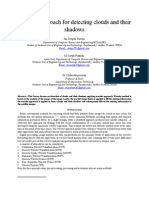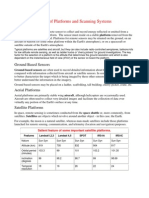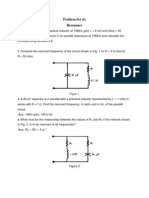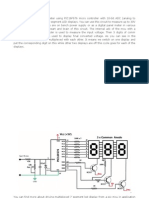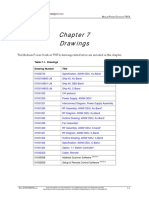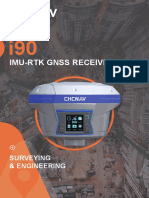Throughput Evaluation of Downlink Multiuser-MIMO OFDM-LTE System
Throughput Evaluation of Downlink Multiuser-MIMO OFDM-LTE System
Uploaded by
Dr shantiCopyright:
Available Formats
Throughput Evaluation of Downlink Multiuser-MIMO OFDM-LTE System
Throughput Evaluation of Downlink Multiuser-MIMO OFDM-LTE System
Uploaded by
Dr shantiOriginal Description:
Original Title
Copyright
Available Formats
Share this document
Did you find this document useful?
Is this content inappropriate?
Copyright:
Available Formats
Throughput Evaluation of Downlink Multiuser-MIMO OFDM-LTE System
Throughput Evaluation of Downlink Multiuser-MIMO OFDM-LTE System
Uploaded by
Dr shantiCopyright:
Available Formats
Int. J.
Communications, Network and System Sciences, 2015, 8, 58-61
Published Online April 2015 in SciRes. http://www.scirp.org/journal/ijcns
http://dx.doi.org/10.4236/ijcns.2015.84007
Throughput Evaluation of Downlink
Multiuser-MIMO OFDM-LTE System
Patteti Krishna1, Tipparti Anil Kumar2, Kalithkar Kishan Rao3
1
JNT University, Hyderabad, Telangana, India
Department of ECE, SR Engineering College, Warangal, Telangana, India
3
Vaagdevi College of Engineering, Warangal, Telangana, India
Email: kpatteti@gmail.com, tvakumar2000@yahoo.co.in, kishanrao6@gmail.com
2
Received March 2015
Abstract
Recently, the mobile communication industry is moving rapidly towards long-term evolution (LTE)
systems. LTE aims to provide improved service quality over 3G systems in terms of throughput,
spectral efficiency, latency, and peak data rate, and MIMO technique is one of the key enablers of
the LTE system for achieving these diverse goals. Among several operational modes of MIMO, multiuser MIMO (MU-MIMO) in which the base station transmits multiple streams to multiple users,
has received much attention as a way for achieving improvement in performance. In this paper we
present a Multiuser MIMO-OFDM-based simulator that includes the main physical layer functionalities and calculate the throughput of LTE Frequency Division Duplex (FDD) and Time Division
Duplex (TDD) systems. The simulator has been used to evaluate the performance of the 3GPP
Long-Term Evolution (LTE) technology.
Keywords
3GPP LTE, OFDM, MIMO, MU-MIMO, FDD, TDD and Throughput
1. Introduction
LTE is one of the most promising wirelesses-technology platforms for the future. The version being deployed
today is just the beginning of a series of innovations that will increase performance, efficiency, and capabilities.
To address the growing mobile broadband demand, the 3 GPP standards body released the next technological
step, Long Term Evolution (LTE) [1] [2]. LTE is designed to substantially improve end-user throughputs, increase sector capacity and reduce user plane latency. Among many features in the LTE which supports up to
3Gbps throughput in downlink, Multi user multiple-input-multiple-output (MU-MIMO) scheme has been identified as one of the key enablers for achieving a high spectral efficiency. Both in theory and design perspectives,
MU-MIMO systems have several unique features distinct from single user MIMO (SU-MIMO) systems [3]. To
make up for the shortcomings of SU-MIMO, early LTE [4] standards (Rel. 8 and 9) defined a primitive form of
the MU-MIMO mode. Many of us might have heard about LTE peak throughput is 300 Mbps, but how many of
us know how we calculate that? This paper provides the information, how this number is calculated? In this paHow to cite this paper: Krishna, P., Kumar, T.A. and Rao, K.K. (2015) Throughput Evaluation of Downlink Multiuser-MIMO
OFDM-LTE System. Int. J. Communications, Network and System Sciences, 8, 58-61.
http://dx.doi.org/10.4236/ijcns.2015.84007
P. Krishna et al.
per, we explained the calculations of theoretical throughput for both the LTE Frequency Division Duplex (FDD)
and Time Division Duplex (TDD) systems [5] [6].
2. System Model
We consider a downlink MIMO-OFDM system with m users, N f subcarriers, nT transmit antennas at the
base station, and nRm receive antennas at the mth mobile station. The data for a particular user, for example, m,
are transmitted in packets, and denoted as S m [ n ] C N m for n = 1, , N f , where N m is the number of spatial
sub channels that are offered from the multiple transmit antennas. Since the channels are assumed to be quasi-static fading from one OFDM symbol to another, the time index is omitted for simplicity. We also assume
that the elements in S m [ n ] are independent identically distributed (i.i.d.) random variables. Let pm [ k , n ] denotes the power that is allocated to the kth spatial sub channel on the nth subcarrier of user m.
With proper guard timing and cyclic prefix, the estimated frequency domain signal is
M
=
Sm [ n ] R m [ n ] H m [ n ] m =1 Tm [ n ] Sm [ n ] + m [ n ]
(1)
where H m [ n ] denotes the MIMO channel matrix from the base station to user m at subcarrier n. The data
symbol vector S m [ n ] is post multiplied by the transmit beam forming matrix Tm [ n ] C K N m before transmitting from the antennas. Having set the transmit power to be pm [ k , n ] , the columns of Tm [ n ] are normalized to 1. The same holds for the receive beam forming matrix R m [ n ] . In addition, the noise m [ n ] is assumed to be i.i.d. complex Gaussian with zero mean and variance of 2 . The fidelity of the signal Sm [ k , n ] is
measured by its SINR, which is given by
m [ k , n] =
M
pm [ k , n ] R m [ k , n ] H m [ k , n ] Tm [ k , n ]
k 1 pm [ k , n] R m [ k , n] H m [ k , n] Tm [ k , n]
m 1=
=
Nm
+ 2
(2)
With the assumption that the interference terms in (2) are Gaussian and independent, from the information-theoretic viewpoint, the achievable aggregate rate for user m, which is denoted as m , becomes
Nf
Nm
=
n 1=
k 1
log 2 (1 + [ k , n ])
(3)
Therefore, the system throughput is
= m =1m
M
(4)
3. Maximum Throughput with Maximum Bandwidth
For any system throughput is calculated as symbols per second. Further it is converted into bits per second depending on the how many bits a symbol can carry. In LTE for 20 MHz, there are 100 Resource Blocks and each
Resource block have 12 7 2 = 168 Symbols per ms in case of Normal CP. So there are 16,800 Symbols per
ms or 16,800,000 Symbols per second or 16.8 Msps. If modulation used is 64 QAM (6 bits per symbol) then
throughput will be 16.8 6 = 100.8 Mbps for a single chain.
For a LTE [7] system with 4 4 MIMO (4T4R) the throughput will be four times of single chain throughput.
i.e. 403.2 Mbps. Many simulations and studies show that there is 25% of overhead used for Controlling and signalling. So the effective throughput will be 300 Mbps. The 300 Mbps number is for downlink and not valid for
uplink. In uplink we have only one transmit chain at UE end. So with 20 MHz we can get Maximum of 100.8
Mbps as calculation shown above. After considering 25% of overhead we get 75 Mbps in uplink. This is the way
how we get the number of throughput 300 Mbps for Downlink and 75 Mbps for Uplink shown everywhere.
Duplex Schemes
Spectrum flexibility is one of the key features of LTE. In addition to the flexibility in transmission bandwidth,
LTE also supports operation in both paired and unpaired spectrum by supporting both FDD-and TDD-based
59
P. Krishna et al.
duplex operation with the time frequency structures. Although the time-domain structure is, in most respects, the
same for FDD and TDD, there are some differences, most notably the presence of a special sub frame in the case
of TDD. The special sub frame is used to provide the necessary guard time for downlink-uplink switching
shown in Table 1.
4. DL and UL Throughput Calculation for LTE FDD
The FDD system has a paired spectrum, same bandwidth for Downlink as well as for Uplink. 20 MHz FDD
system have 20 MHz for Downlink and 20 MHz for Uplink. For throughput calculation, suppose:
Bandwidth20 MHz
Multiplexing scheme-FDD
UE category-Cat. 3
Modulation supportedas per Cat 3 TBS index 26 for DL (75376 for 100RBs) and 21 for UL (51024 for 100
RBs)
So the throughput can be calculated by a simple formula:
Throughput = Number of Chains TB size
So DL throughput = 2 75376 = 150.752 Mbps
UL throughput = 1 51024 = 51.024 Mbps
As we have 2 receive chains and one transmits chain.
5. LTE TDD and Its Frame Structure
Before starting throughput calculation, lets become familiar with LTE-TDD [6]. As stated earlier, TDD is unpaired spectrum. We have to use same bandwidth for DL and UL on time sharing basis. Suppose if we have 20
MHz spectrum, we have to use this 20 MHz bandwidth for both DL and UL.LTE TDD frame structure is shown
in Figure 1. The TD frame consists of Downlink sub frame, Uplink and Special sub frame.
There are seven possible configurations for LTE TDD frame as shown below. Here D-is downlink, S-for Special sub frame and U- for Uplink. As shown 5 ms periodicity frame have two S sub frame and 10 ms frames
have only one S sub frame.
Special sub frame has 9 different configurations [8]. A special sub frame is divided into Downlink Pilot Time
Slot (DwPTS), Guard Period (GP) and Uplink Pilot Time Slot (UpPTS) depending upon the number of symbols.
Figure 1. TDD frame structure.
Table 1. Uplink-downlink allocations.
UL-DL configuration
Downlink to up link switch periodicity
Sub frame number
0
5 ms
5 ms
5 ms
10 ms
10 ms
10 ms
5 ms
60
6. DL and UL Throughput Calculations for LTE TDD
P. Krishna et al.
TDD system throughput calculations are somewhat complex as compared to FDD system as same spectrum is
used by uplink, downlink and for the guard period (Used for transition from downlink to uplink) [9].
For throughput calculation, suppose:
Bandwidth20 MHz
Multiplexing Scheme-TDD
TDD Configuration-2 (D-6, S-2 and U-2)
Special Sub frame configuration-7 (DwPTS-10, GP-2 and UpPTS-2)
UE category-Cat. 3
Modulation supportedas per Cat 3 TBS index 26 for DL (75376 for 100 RBs) and 21 for UL (51024 for 100
RBs). Throughput in TDD can be calculated by following formula
DL Throughput = Number of Chains TB size (Contribution by DL Sub frame + Contribution by DwPTS
in SSF).
UL Throughput = Number of Chains TB size (Contribution by UL Sub frame + Contribution by UpPTS
in SSF). TB size for DL is 75376 and for UL it is 51,024 for category 3 UE.
Lets calculate throughput for the above assumptions:
DL throughput = 2 75376 [(0.6 + 0.2 (10/14)]
Here 0.6% or 60% contribution is by 6 DL sub frame and [0.2(10/14)] factor contribution by Special sub
frame comes twice whose 10 symbols out of 14 are for downlink.
So DL throughput = 2 75376 (0.742857) = 111.9872 Mbps 112 Mbps.
In same manner UL throughput will be
UL throughput = 1 51024 [(0.2 + 0.2 (2/14)]
Here 0.2% or 20% contribution is by 2 UL sub frame and [0.2 (2/14)] factor contribution by Special sub
frame comes twice whose 2 symbols out of 14 are for uplink.
So UL throughput = 1 51024 (0.228571) = 11.66263 12 Mbps.
7. Conclusion
In this paper, we discussed about LTE system throughput calculation for both TDD and FDD system. 3 GPP
LTE technology support both TDD and FDD multiplexing. The paper describes all the factors which affect the
throughput like Bandwidth, Modulation, UE category and multiplexing. It also describes how we get throughput
300 Mbps in DL and 75 Mbps in UL and what are assumptions taken to calculate the same. Paper describes the
steps and formulae to calculate the throughput for FDD system for TDD Configuration 1 and Configuration 2.
References
[1]
Dahlman, E., Parkvall, S. and Skold, J. (2011) 4G LTE/LTE-Advanced for Mobile Broadband. Academic Press.
[2]
Sesia, S., Toufik, I. and Baker, M. Lte-The Umts Long Term Evolution from Theory to Practice. 2nd Edition.
[3]
Boccardi, F., Clerckx, B., Ghosh, A., Hardouin, E., Jongren, G., Kusume, K., Onggosanusi, E. and Tang, Y. (2012)
Multiple-Antenna Techniques in LTE-Advanced. IEEE Communications Magazine, 50, 114-121
[4]
3GPP TS 36.213. Evolved Universal Terrestrial Radio Access (E-UTRA) Physical Layer Procedures.
[5]
(2009) 3GPP LTE for TDD Spectrum in the Americas.
[6]
Ratasuk, R., et al. (2008) TDD Design for UMTS Long Term Evolution. PIMRC-2008, Cannes.
[7]
Holma, H. and Toskala, A. (2009) LTE for UMTS: OFDMA and SC-FDMA Based Radio Access, 267.
[8]
(2013) Cisco Visual Networking Index: Global Mobile Data Traffic Forecast Update, 2012-2017.
[9]
Toward 4G. http://www.nttdocomo.com/technologies/future/toward/index.html
61
You might also like
- DMRS Design and Channel Estimation For Lte Advanced ULDocument16 pagesDMRS Design and Channel Estimation For Lte Advanced ULStefano Della PennaNo ratings yet
- From GSM to LTE-Advanced Pro and 5G: An Introduction to Mobile Networks and Mobile BroadbandFrom EverandFrom GSM to LTE-Advanced Pro and 5G: An Introduction to Mobile Networks and Mobile BroadbandNo ratings yet
- Performance Analysis of Multicarrier DS-CDMA System Using BPSK ModulationDocument7 pagesPerformance Analysis of Multicarrier DS-CDMA System Using BPSK ModulationiaetsdiaetsdNo ratings yet
- Performance Evaluation of Mimo Schemes in MHZ Bandwidth Lte SystemDocument5 pagesPerformance Evaluation of Mimo Schemes in MHZ Bandwidth Lte SystemRoman_EANo ratings yet
- LTE Dissertation 2014Document40 pagesLTE Dissertation 2014Ali AlgadeedNo ratings yet
- Simple Capacity Estimations in Wimax/802.16 System: Loutfi Nuaymi, Ziad NounDocument5 pagesSimple Capacity Estimations in Wimax/802.16 System: Loutfi Nuaymi, Ziad NounMuharry HabibNo ratings yet
- Modeling A Link Level Simulator For Long Term Evolution UplinkDocument5 pagesModeling A Link Level Simulator For Long Term Evolution UplinkMihaela HainarosieNo ratings yet
- MC-CDMA With Quadrature Spreading For Wireless Communication SystemsDocument25 pagesMC-CDMA With Quadrature Spreading For Wireless Communication SystemsNageswara Rao ChallaNo ratings yet
- VLSI Implementation of Hard-And Soft-Output Sphere Decoding For Wide-Band MIMO SystemsDocument27 pagesVLSI Implementation of Hard-And Soft-Output Sphere Decoding For Wide-Band MIMO SystemsVimalNo ratings yet
- 16x16 Multiuser MIMO Testbed Employing Simple AdaptiveDocument5 pages16x16 Multiuser MIMO Testbed Employing Simple AdaptiveNhật LongNo ratings yet
- 10vlsisoc SphereDocument6 pages10vlsisoc SphereDuy NvNo ratings yet
- Performance Analysis of Multiuser MIMO Systems With Zero Forcing ReceiversDocument5 pagesPerformance Analysis of Multiuser MIMO Systems With Zero Forcing ReceiversNetsanet JemalNo ratings yet
- 61 - Vidya SDocument7 pages61 - Vidya SRiki RiskiNo ratings yet
- Performance Analysis of MIMO-OFDM LTE Communication and LTE Multicast Systems in Jamming EnvironmentDocument7 pagesPerformance Analysis of MIMO-OFDM LTE Communication and LTE Multicast Systems in Jamming EnvironmentInnovative Research PublicationsNo ratings yet
- PAPR Reduction of An MC-CDMA System Using SLM Technique: Gagandeep Kaur, Rajbir KaurDocument5 pagesPAPR Reduction of An MC-CDMA System Using SLM Technique: Gagandeep Kaur, Rajbir KaurIjarcet JournalNo ratings yet
- Successive Interference Cancellation Schemes in Multi-Rate Ds/Cdma SystemsDocument15 pagesSuccessive Interference Cancellation Schemes in Multi-Rate Ds/Cdma SystemsHadi KasasbehNo ratings yet
- Distributed Interference Management and Scheduling in LTE-A Femto NetworksDocument5 pagesDistributed Interference Management and Scheduling in LTE-A Femto NetworksRanga KrishnanNo ratings yet
- A New Approach For Finite-Length Framework of Multi-Input Multi-Output MmseDocument6 pagesA New Approach For Finite-Length Framework of Multi-Input Multi-Output MmseTavvaNo ratings yet
- Performance Comparisons Between Greedy and Lagrange Algorithms in Adaptive MIMO MC-CDMA SystemsDocument5 pagesPerformance Comparisons Between Greedy and Lagrange Algorithms in Adaptive MIMO MC-CDMA SystemsFirman Nico ChandraNo ratings yet
- Uplink Versus Downlink Wirless Mobile Positioning in Umts Cellular Radio SystemsDocument4 pagesUplink Versus Downlink Wirless Mobile Positioning in Umts Cellular Radio SystemsEmad NiriNo ratings yet
- Performance Analysis of Sc-FDMA and OFDMA in LTE Frame StructureDocument8 pagesPerformance Analysis of Sc-FDMA and OFDMA in LTE Frame StructureAjay Kumar SwarnkarNo ratings yet
- Performance of LTE ADVANCED Uplink in A Flat Rayleigh ChannelDocument9 pagesPerformance of LTE ADVANCED Uplink in A Flat Rayleigh ChannelDinesh SekarNo ratings yet
- Channel Estimation For Adaptive Frequency-Domain EqualizationDocument11 pagesChannel Estimation For Adaptive Frequency-Domain Equalizationअमरेश झाNo ratings yet
- 2.schedueling Algorithm For LTEDocument5 pages2.schedueling Algorithm For LTESanjay ShelarNo ratings yet
- Analyses and Performance of PDFDocument14 pagesAnalyses and Performance of PDFJohn BergNo ratings yet
- Ijcnc 050313Document13 pagesIjcnc 050313AIRCC - IJCNCNo ratings yet
- Radon Transform PaperDocument8 pagesRadon Transform Papersarin.gaganNo ratings yet
- WPMC2006 Paper221 KRJ Wak FinalDocument5 pagesWPMC2006 Paper221 KRJ Wak FinalHumayun KabirNo ratings yet
- A 4x4 MIMO-OFDM System With MRC in A Rayleigh Multipath Channel For WLANDocument4 pagesA 4x4 MIMO-OFDM System With MRC in A Rayleigh Multipath Channel For WLANzizo1921No ratings yet
- Ieee 802.11N: On Performance of Channel Estimation Schemes Over Ofdm Mimo Spatially-Correlated Frequency Selective Fading TGN ChannelsDocument5 pagesIeee 802.11N: On Performance of Channel Estimation Schemes Over Ofdm Mimo Spatially-Correlated Frequency Selective Fading TGN Channelszizo1921No ratings yet
- Coverage/Capacity Analysis For 4 Generation Long Term Evolution (Lte)Document6 pagesCoverage/Capacity Analysis For 4 Generation Long Term Evolution (Lte)Alit Putra WijayaNo ratings yet
- MultiRate in DS - CDMADocument5 pagesMultiRate in DS - CDMAMohamed AbdelBasetNo ratings yet
- MIMO Technologies in 3GPP LTE and LTE-AdvancedDocument11 pagesMIMO Technologies in 3GPP LTE and LTE-AdvancedPreyas HathiNo ratings yet
- A Novel Preamble Design For Channel Estimation in Mimo-Ofdm Systems Resulting in Enhanced ThroughputDocument5 pagesA Novel Preamble Design For Channel Estimation in Mimo-Ofdm Systems Resulting in Enhanced ThroughputNoha HassanNo ratings yet
- Enhancing The Performance of LEACH Protocol in Wireless Sensor NetworksDocument6 pagesEnhancing The Performance of LEACH Protocol in Wireless Sensor NetworksjeevithaNo ratings yet
- International Journal of Computational Engineering Research (IJCER)Document6 pagesInternational Journal of Computational Engineering Research (IJCER)International Journal of computational Engineering research (IJCER)No ratings yet
- Ofdm Cognitive Radio ThesisDocument4 pagesOfdm Cognitive Radio Thesisjmvnqiikd100% (2)
- Lucent 1 X Diversity SchedulingDocument7 pagesLucent 1 X Diversity SchedulingRafid A. Jassem AlashorNo ratings yet
- Pilot and Data Aided Channel Estimation For Uplink MC-CDMA Mobile SystemsDocument5 pagesPilot and Data Aided Channel Estimation For Uplink MC-CDMA Mobile SystemsAnonymous BkmsKXzwyKNo ratings yet
- MIMO Technology For Advanced Wireless Local Area NetworksDocument3 pagesMIMO Technology For Advanced Wireless Local Area NetworksRakesh RtNo ratings yet
- Performance Improvement of Mc-Cdma System Through DSTBC Site DiversityDocument8 pagesPerformance Improvement of Mc-Cdma System Through DSTBC Site Diversityمحمد الطراونهNo ratings yet
- Signal Detection For 3GPP LTE Downlink: Algorithm and ImplementationDocument14 pagesSignal Detection For 3GPP LTE Downlink: Algorithm and ImplementationThanh HoangNo ratings yet
- Improving MIMO Spectral Efficiency in 4G Macro-Cellular NetworksDocument6 pagesImproving MIMO Spectral Efficiency in 4G Macro-Cellular Networksወንድሙ ዘገዬNo ratings yet
- The Improvement of End To End Delays in Network Management System Using Network CodingDocument20 pagesThe Improvement of End To End Delays in Network Management System Using Network CodingAIRCC - IJCNCNo ratings yet
- Spreading Factor TradeoffDocument6 pagesSpreading Factor TradeoffAmrit AulakhNo ratings yet
- Exploiting The Adaptive Modulation Scheme To Increase The Throughput Performance of 3GPPLTE Downlink Interface AirDocument7 pagesExploiting The Adaptive Modulation Scheme To Increase The Throughput Performance of 3GPPLTE Downlink Interface AirIOSRJEN : hard copy, certificates, Call for Papers 2013, publishing of journalNo ratings yet
- LTE E-UTRAN and Its Access Side Protocols: Authors: Suyash Tripathi, Vinay Kulkarni, and Alok KumarDocument22 pagesLTE E-UTRAN and Its Access Side Protocols: Authors: Suyash Tripathi, Vinay Kulkarni, and Alok KumarEivar Davila SanchezNo ratings yet
- Prospects of MIMO Techniques For Broadband Wireless Systems: T. Blajić, M.Družijanić, Z. ČimićDocument6 pagesProspects of MIMO Techniques For Broadband Wireless Systems: T. Blajić, M.Družijanić, Z. ČimićDamir MuzicNo ratings yet
- Channel Estimation LmmseDocument31 pagesChannel Estimation LmmseNabeel JarralNo ratings yet
- A Fast Automatic Gain Control Scheme For 3GPP LTE TDD SystemDocument5 pagesA Fast Automatic Gain Control Scheme For 3GPP LTE TDD SystemnuslizNo ratings yet
- Performance of Multiple-Input and Multiple-Output Orthogonal Frequency and Code Division Multiplexing Systems in Fading ChannelsDocument11 pagesPerformance of Multiple-Input and Multiple-Output Orthogonal Frequency and Code Division Multiplexing Systems in Fading ChannelsmsljyothiNo ratings yet
- Femtocell Macrocell Interference Analysis For Mobile WiMAX SystemDocument5 pagesFemtocell Macrocell Interference Analysis For Mobile WiMAX Systemsameh04No ratings yet
- MIMO Channel Estimation Using The LS and MMSE Algorithm: Mohammed Ali Mohammed MOQBEL, Wangdong, Al-Marhabi Zaid AliDocument10 pagesMIMO Channel Estimation Using The LS and MMSE Algorithm: Mohammed Ali Mohammed MOQBEL, Wangdong, Al-Marhabi Zaid AliKoustab MaityNo ratings yet
- Analysis of Successive Interference Cancellation Scheme With M-Ary QAM in DS/CDMA SystemsDocument4 pagesAnalysis of Successive Interference Cancellation Scheme With M-Ary QAM in DS/CDMA Systemsalexandr745No ratings yet
- Relationship Between EsN0 and EbNo in OFDMDocument8 pagesRelationship Between EsN0 and EbNo in OFDMfriendindeedNo ratings yet
- IAETSD-A Novel Scheduling Algorithms For MIMO Based Wireless NetworksDocument10 pagesIAETSD-A Novel Scheduling Algorithms For MIMO Based Wireless NetworksiaetsdiaetsdNo ratings yet
- Analytical Modeling of Wireless Communication SystemsFrom EverandAnalytical Modeling of Wireless Communication SystemsNo ratings yet
- Software Radio: Sampling Rate Selection, Design and SynchronizationFrom EverandSoftware Radio: Sampling Rate Selection, Design and SynchronizationNo ratings yet
- Toshiba KRE1012030Document2 pagesToshiba KRE1012030ahmadNo ratings yet
- Jdsu Smartclass Ethernet User ManualDocument3 pagesJdsu Smartclass Ethernet User ManualWilson Mota SantosNo ratings yet
- 6G Technology OverviewDocument203 pages6G Technology OverviewCarl0217No ratings yet
- 1357 4G PDFDocument6 pages1357 4G PDFarunsamuel2002No ratings yet
- 2 N 4957Document5 pages2 N 4957Marco Eduardo Zambrano MatuteNo ratings yet
- SNCPDocument1 pageSNCPImtiaz AhmedNo ratings yet
- Chairs Be OhDocument29 pagesChairs Be OhAnand ReddyNo ratings yet
- GSM Services: Global System For Mobile Communications (GSM)Document6 pagesGSM Services: Global System For Mobile Communications (GSM)Sarbjeet SinghNo ratings yet
- 37.sai DeepthiDocument8 pages37.sai DeepthiSanjay SinglaNo ratings yet
- 28GHz LMDS Datasheet Point To MultiPointDocument2 pages28GHz LMDS Datasheet Point To MultiPointyoiussef100% (1)
- Chopper Stabilization: Iabraham 22 Jan 2009Document26 pagesChopper Stabilization: Iabraham 22 Jan 2009Sai NaramNo ratings yet
- WC01-Introduction To Wireless CommunicationsDocument75 pagesWC01-Introduction To Wireless CommunicationsKhoa Đăng LaNo ratings yet
- AC Antennas Marine-Catalogue 2018Document24 pagesAC Antennas Marine-Catalogue 2018son nguyenNo ratings yet
- Random Processes Sept 25 26 Oct 3 5Document53 pagesRandom Processes Sept 25 26 Oct 3 5Shravani KodeNo ratings yet
- FM 5CFMi 402 - FM 4CFMi 301 Technical ManualDocument264 pagesFM 5CFMi 402 - FM 4CFMi 301 Technical ManualDouglas DucoteNo ratings yet
- An Approach To Creating Wireless Network Interface Amongst Ipv4, Ipv6 and Dual Stack NetworksDocument5 pagesAn Approach To Creating Wireless Network Interface Amongst Ipv4, Ipv6 and Dual Stack Networksmikhael riko100% (1)
- Types of Platforms and Scanning SystemsDocument3 pagesTypes of Platforms and Scanning SystemsNaga RajaNo ratings yet
- Selfwork Anti-StealthradarDocument11 pagesSelfwork Anti-StealthradarAnaniya AgarwalNo ratings yet
- ResonanceDocument3 pagesResonanceBoules Atef0% (1)
- ZXSDR B8200 Product Description - UniRAN21+ (V5.45.20) +BPQ7 - V1.0Document39 pagesZXSDR B8200 Product Description - UniRAN21+ (V5.45.20) +BPQ7 - V1.0lankesha.ghnNo ratings yet
- AVR309 USB To UART Protocol Converter: FeaturesDocument19 pagesAVR309 USB To UART Protocol Converter: FeaturesValdenir DuarteNo ratings yet
- This Is A Simple 30V Volt Meter Using PIC16F676 Micro Controller With 10Document7 pagesThis Is A Simple 30V Volt Meter Using PIC16F676 Micro Controller With 10dindo_condesNo ratings yet
- Medical Images Compression and Encryption Using DCT Arithmetic Encoding and Chaos-Based EncryptionDocument5 pagesMedical Images Compression and Encryption Using DCT Arithmetic Encoding and Chaos-Based EncryptionVitNo ratings yet
- Removing The PDCCH Bottleneck and Enhancing The Capacity of 4G Massive MIMO SystemsDocument8 pagesRemoving The PDCCH Bottleneck and Enhancing The Capacity of 4G Massive MIMO SystemsD Harish KumarNo ratings yet
- Communication ReviewerDocument3 pagesCommunication ReviewerAchilles Aldave100% (1)
- 01031254rJ Chapter 7 DrawingsDocument98 pages01031254rJ Chapter 7 DrawingsVasilyNo ratings yet
- CH 02Document54 pagesCH 02Food FeedNo ratings yet
- MDS Radio 9810 User ManualDocument80 pagesMDS Radio 9810 User Manuallboone289No ratings yet
- Imu-Rtk Gnss Receiver: Surveying & EngineeringDocument4 pagesImu-Rtk Gnss Receiver: Surveying & EngineeringRicardo Barros da CruzNo ratings yet
- CobraNet Networking GuideDocument30 pagesCobraNet Networking Guide安斎 幹No ratings yet





